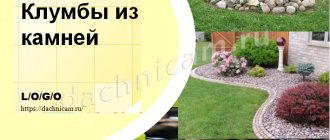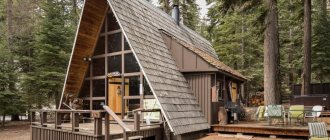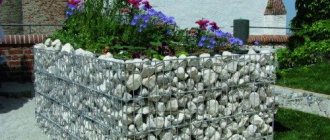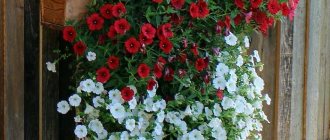Having free space on the site is an excellent opportunity to diversify the landscape by adding an unusual flower bed made of crushed stone or gravel. Such a flower garden will not cause problems during the maintenance process and will become an effective element of decor; it can be decorated exactly the way you want, thanks to the convenience of the source material. A do-it-yourself crushed stone flowerbed is an excellent option even for inexperienced gardeners. Everyone can create a real work of landscape art by showing their imagination.
What is a gravel bed
A gravel flower garden is a small or medium-sized plot of land, the space of which, with the exception of the place for planting plants, is completely covered with crushed stone. The selection of plants for such a flower bed depends on the overall design of the garden, but most often gardeners choose evergreen or decorative deciduous perennials. Herbaceous annual plants are used much less frequently, since with them the flowerbed will quickly lose the desired decorative effect.
Important! Gravel can reduce the evaporation of water from the soil and can reduce the frequency of watering plants; in summer it prevents soil heating, and in winter it protects from frost. This versatile material also limits the growth of weeds.
Flowers in flowerpots will also look beautiful if included in the composition of a gravel bed. The pots can be dug into the soil and sprinkled with the smallest stones, or simply placed securely on the surface of the gravel backfill. One of the main advantages of such a gravel flowerbed with your own hands is the ability to change the location of the flowerpots at your discretion and at any time. A huge number of design options for a flower bed based on crushed stone allows you to create a flower garden of any type.
Drainage materials
Only materials of inorganic origin are suitable for creating a drainage layer. Moreover, they must be chemically neutral and have good resistance to destruction and oxidation. For example, marble chips are absolutely not suitable for drainage, since with prolonged interaction with water, they significantly reduce the acidity of the soil, making it excessively alkaline. Fine materials, such as gravel or sand, are also not particularly suitable as primary drainage. Over time, they become thoroughly compacted and clog the drainage holes.
Expanded clay
It is for this material that the word “Drainage” has become a household name among amateur flower growers. It is under this name that it is sold. What is the difference between construction expanded clay and drainage, “flower” expanded clay? Yes, actually nothing. In any case, from the point of view of the source material and manufacturing technology. In both cases, these are burnt lumps of clay. But there is still a difference. Firstly, before going on sale, it is washed and cleared of dirt and dust, and secondly, the drainage expanded clay is calibrated according to the size of the fraction. Therefore, on sale you can find expanded clay of small, medium and large fractions from 5 to 20 millimeters. It is selected based on the size of the flower pot and the diameter of the drainage holes. Balls - granules should not clog the holes or spill through them.
There is a lot of debate among professional gardeners about the advisability of using expanded clay as a drainage material. Despite its undeniable advantages, such as environmental friendliness, high hygroscopicity, lightness, counterarguments can also be found. The main one is increasing the acidity of the nutrient solution that the roots consume. You can agree with this statement, or you can argue. In any case, your humble servant has been using expanded clay as a drainage material for many years, and has not noticed any negative effect on plants. Nevertheless:
Gravel, crushed stone, river pebbles
These materials are classified as “second-hand” and can hardly be bought in a store. Therefore, their calibration and cleaning falls on the shoulders of the grower. At its core, this is also a pretty good drainage material. Its main advantage is durability. When using these materials, you need to pour an additional layer of vermiculite or perlite on top of them. This will protect the plant roots from hypothermia and overheating.
Ceramic shards
When using ceramic shards, we get a combination of the advantages of expanded clay and pebbles. Ceramics, despite the similarity of manufacturing technology and material, is more durable than expanded clay. At the same time, it is capable of not only removing excess moisture from the roots of indoor flowers, but also accumulating it, preventing the soil from drying out completely.
Only clean, unglazed ceramics are suitable for use as drainage. Most tableware is not suitable for drainage.
At the same time, clay shards must be used very carefully. They usually have sharp, jagged edges
First you need to dull them. Otherwise, there is a high probability of damage to the roots. To avoid such injuries, as well as for better passage of moisture, clay shards should be laid with the convex side up, and sprinkled on top with a thin layer of fine expanded clay or vermiculite.
Broken brick
This material is most often used for growing succulents and plants in pots without drainage holes. Only red brick can be used. Its properties are similar to ceramics. Before creating a drainage layer from broken bricks, it also needs to be prepared. Thoroughly clean from dust and dirt, treat sharp edges.
Styrofoam
It is used as often as expanded clay. This is the cheapest and most readily available drainage material. Polystyrene foam is not able to absorb moisture and retain it, but it is quite suitable for draining excess water. Moreover, unlike bricks, pebbles and shards, polystyrene foam is much lighter, which means it does not weigh down the pot. In addition, it protects the roots of the plant from hypothermia on cold windowsills in winter. At the same time, you should not abuse its use. It is perfect for plants with underdeveloped root systems or for flowers that are replanted annually. Such as geranium, chlorophytum or hydrangea, if they overwinter in a pot and are planted in open ground in the summer. The fact is that plant roots are able not only to entwine pieces of polystyrene foam, but to penetrate through them (as into a hydrogel). Then, during the next transplant, it will be impossible to remove them without damaging the roots.
Advantages and disadvantages of a flower bed with crushed stone
Flowerbeds made of coarse crushed stone or fine gravel look original and interesting; this is the best option for those who want to diversify the design of their site. For such flower beds, both large and small stones are used, depending on the location of the flower bed and the type of landscape. To make the flower garden look more interesting, it is better to use decorative gravel of various sizes and combine it at your discretion. A large number of advantages make such flower beds more popular among gardeners looking for non-standard design solutions for their plots:
- does not require serious maintenance due to the absence of weeds, since they are based on a backfill of stones;
- flower beds can be laid out anywhere in the territory, in the shade or in the sun, on a sloping surface or plain;
- can have any size, shape or decor;
- allow you to water and fertilize plantings much less frequently;
- They give the garden a well-groomed appearance and are an original element of the landscape.
An additional bonus is the low price of the material and its environmental friendliness; it protects the root system of planted plants by blocking air exchange. The gravel finish does not cause any difficulties when creating a flower garden and goes well with other materials, such as wood, moss or metal.
Among the disadvantages of filling a flower bed with gravel, it is worth noting the problems during harvesting in the fall, when it needs to be cleaned of fallen leaves.
Application examples
Until recently, gravel filling in landscape design was used only to create a patio; today, the scope of application of loose structures has expanded significantly.
With their help, tracks are often created. All types of listed materials are suitable for these purposes, except for inorganic artificial materials. Stone screes in rockeriesSource nashgazon.com
Backfill helps create the effect of “stone screes” in rock gardens, form mounds of alpine hills, and emphasize the beauty of individual plants. Plant a spreading flowering bush in the center of a stone clearing, and you will see how well such a soloist will demonstrate its beauty. Designers love to use bulk materials when creating flower beds or to form separate zones. They help prevent the growth of plants: areas of bare soil between them will eventually be filled with grass, and this will have a bad effect on the decorative properties of the individual element. When the open ground is filled with crushed stone or gravel, pine bark or cedar waste, the garden will take on a finished appearance.
Backfill helps give the garden a finished appearance Source avatars.mds.yandex.net
High-quality decorative filling of slopes with crushed stone at the dacha also helps to solve complex practical problems. It prevents the spreading of the earth, covers a large area, hides its most unsightly sides
Make the filling multi-colored, get a bright decorative element that will immediately catch the eye and distract attention from other imperfections of the site
How to make a flowerbed with gravel
To make a flowerbed with crushed stone with your own hands in a country house or on a site at home, it is important to choose a place to place it. Depending on its size, you can determine the exact amount of materials. First of all, you need to choose the main material - crushed stone of various fractions and shades, depending on the design of the flower bed. For the work you will also need to purchase a special mulching cloth with fastenings, a weed membrane and containers for planting plants.
Soil preparation
First of all, you need to select a suitable area where the gravel flower beds will be located, and determine its boundaries using pegs with a stretched rope. The top layer of soil to a depth of at least 20 cm must be removed from the site, and its surface should be leveled. The place must be completely cleared of weeds along with the roots. In order not to miss those weeds that have not yet sprouted, the ground needs to be watered and left for up to a week until the sprouts appear, then remove them too.
Important! Decorating flower beds with crushed stone is not only beautiful, but also profitable. With them, the garden always looks well-groomed, and the plants are reliably protected from weeds and other unfavorable factors under a layer of gravel.
After removing the weeds and preparing the ground, the site is dug up, adding expanded clay or coarse sand in the process. Next, the soil is compacted using a garden roller and covered with the first layer of mulch, which will prevent the gravel from subsiding and the growth of perennial weeds. When the area is completely covered with fabric, it will be necessary to make holes in it every 3 square meters. m. in order to remove excess water. In the process of decorating a flowerbed with crushed stone, such measures will help create a perfectly even layer.
Preparing a place for planting
To prepare the site, you will need to make holes for planting in geotextile material, having previously determined how many plants you plan to grow in the flower garden. The holes must match the size of the planting containers. In each of them you need to dig a small hole, fill it with soil and plant a plant. Soft containers are ideal for gravel beds; they protect the roots of flowers and shrubs, and also reliably separate a layer of plain or colored crushed stone for flower beds from the planting site.
Advice! Small conifers, palms, azaleas, yuccas, maples, hydrangeas and ornamental grasses work best with gravel. They can be advantageously combined to form interesting compositions.
You can plant plants after decorating the flower beds with gravel; to do this, you need to remove excess gravel in the planting areas. Then make holes in the mulching sheet, bend its edges down and make a hole in the soil for the seedling. Afterwards, plants are planted in the prepared holes, sprinkled with a layer of soil and watered after distributing the removed gravel.
How to fill a flowerbed with crushed stone
To properly lay decorative crushed stone in a flowerbed, you need to prepare the soil and level its surface. Next, the gravel is evenly distributed over the site, making sure that its first layer is at least 3 cm. A thinner layer will provoke the growth of weeds due to the presence of gaps between the crushed stone and the soil. It is better to make the layer thicker so that weeds do not interfere with the plants in the future flower bed. Plant types also need to be taken into account, for example, a thick gravel layer is better for rhododendrons and azaleas.
The function of the first layer is to remove rainwater and drainage. A second sheet of geotextile is laid on it, designed to separate the main and decorative layers of crushed stone. The final stage is the filling of a decorative layer, with which the geotextile is masked; it should be completely hidden under plain or colored crushed stone for flower beds. At this stage, the composition of the flower bed is also formed, taking into account the previously developed design of the picture.
Is a binder required?
When building the main highways on the site, roads along the house, it is better to build a path of crushed stone and epoxy resin - the so-called “stone carpet”, which was already mentioned above. Granite crushed stone is most suitable for this purpose. It is beautiful in color, repeating granite with splashes of red and black, and is wear-resistant.
Glue for crushed stone can be purchased in specialized stores. The base for such passages is additionally reinforced with concrete pouring. The foundation pit for the road is dug to a depth of 25-30 cm. The soil is dug up and compacted. The edges are aligned strictly vertically, and a wooden frame (formwork) made of slats with transverse ties is mounted on them. The latter hold the edges of the highway in a vertical position. It is advisable to install them every 70-80 cm.
A 15 cm drainage layer of crushed stone is poured onto the bottom of the trench, pressed, and compacted with a 5 cm layer of sand. The base is compacted, watered, and allowed to settle. Then the layer of sand is leveled, and a geofabric is laid on top of it. To ensure the strength of the base, a concrete solution with the addition of crushed stone of fraction 5-10 or 5-20 is poured over the geofabric. Concrete layer 8-10 cm.
When the concrete base is dry and can be walked on, begin pouring the stone resin. The finest fraction of crushed stone is poured into the mixer, a binding component is added - epoxy resin and glue (hardener). The packaging contains instructions for making the composition. All components continue to be mixed for 20-30 minutes until the greatest uniformity of glue distribution is achieved. Here is the approximate ratio of components:
- crushed stone fraction 10-20 – 80 kg;
- epoxy resin – 1.3 kg;
- glue – 10 g.
Furfuryl alcohol may be needed to thin hardened resin.
A mixture of crushed stone and adhesive is poured onto the concrete base in a layer of 1-5 cm and actively leveled and compacted using a trowel. You can only use a scraper if the mixture is dense and only needs to level the layer in height. They try to work quickly, as the mixture is actively hardening. The time during which the track is ready for use is 1-2 hours. After setting, the coating is watered. The mixture of crushed stone and glue allows water to pass through well, precipitation does not accumulate on it, and less ice forms in winter.
How to paint crushed stone for a flowerbed with your own hands
Ordinary crushed stone can be turned into decorative one by painting it in different colors depending on the design of the flower garden. The technology for coloring crushed stone for a flower bed is not complicated; when choosing high-quality dyes, the stones retain their original color for a long time. Special aerosol enamel in cans, as well as acrylic or alkyd paints, are suitable for them.
The process consists of several stages:
- The selected stones must be thoroughly washed.
- Paint each stone on one side and the other in the desired color, waiting until the paint dries.
- The paint is applied in a thin layer; if in the end the color is not too bright, the process can be repeated.
The method of painting each stone is suitable for processing small quantities. When there is a lot of gravel, it is poured into a large container and paint is poured on top, thoroughly mixing the stones. A concrete mixer is well suited for these purposes. Flowerbeds with white crushed stone look no less impressive, but often site owners prefer a more original decor.
Why are drainage holes needed in a flower pot?
In addition to proper drainage, it is important to find a good pot for planting. When purchasing a container, pay attention to whether it has drainage holes, what size they are and how they are located. If the holes are too small, the moisture will drain slowly, if they are large, the moisture will drain quickly. If there are no holes at all, they can be made at home using a drill with a suitable drill diameter.
To ensure the correct soil moisture for certain indoor plants, you should choose a container with the correct holes:
- For succulents, cacti and some types of orchids, moisture must drain quickly. A small pot with porous soil and small holes is suitable for them.
- For plants growing in high humidity, it is better to select containers with dense soil and a minimum of small holes.
Drainage holes in flower pots
What plants to plant in a gravel bed
The versatility of a gravel flower garden allows you to use many different types of plants. When choosing them, it is necessary to take into account the overall design of the landscape and the chosen decor of the flower bed. Plot owners can make a gravel flower bed without grass or use coniferous plants. Cypress, boxwood, yucca, yew and Rogersia trees look especially beautiful on light crushed stone.
Shrubs with bright and variegated foliage, for example, Fortune's euonymus, hydrangeas, Thunberg barberry and others, will also look impressive.
There are many types of plants that can be used in the composition, for example, a gravel flowerbed with conifers is considered the most popular option. It’s easier to remember which ones are best not to choose; these are fast-growing plantings and plants that require frequent replanting.
Mistakes when making your own
Florists make the following mistakes when making drainage:
- Using sand, which compacts and does not allow moisture to pass through.
- The fraction of drainage material is over 3 cm, which does not retain moisture.
- The use of organic materials that rot over time.
- Use of chemically unstable materials.
- Laying drainage with sharp edges that damage the roots of indoor plants.
The healthy appearance of the plant, growth and development depend on the condition of the soil and drainage layer. Properly laid drainage will provide the required humidity for a particular type of indoor plant.
5/5 — (2 votes)
Photo ideas of flower beds with decorative crushed stone (gravel)
The number of ideas for decorating flower beds with crushed stone is limited only by the imagination of the owner of the site. Below are the most interesting and non-standard gravel flower beds with photos, which you can easily make step by step with your own hands using colored or plain crushed stone.
Specifications
Basically, the main requirement that can be presented to crushed stone is adhesion. As a rule, it is not bad even for recycled materials.
But, given that crushed stone is used in construction as an important component of certain stages, the quality of all work carried out sometimes depends on its other technical parameters.
So, crushed stone, like any building material, determines its technical qualities and properties according to the following parameters:
- Strength.
- Frost resistance.
- Density.
- Radioactivity.
Strength
The resistance of a material to mechanical stress is determined by compression or crushing. And always when the crushed stone is saturated with water. The tensile strength of crushed stone is measured at 20 MPa. Crushed stone samples are placed in a special cylinder and then in a shelf drum. After which a grade is assigned, which can characterize the crushed stone as:
- Highly durable. Grade M 1,200 – 1,400. Crushed stone of weak rocks here should be less than 5% of the total mass.
- Lasting. Crushed stone of weak rocks here should be at the level of 5%.
- Medium strength. There should be no more than 10% crushed stone of weak rocks here.
- Weak strength. Crushed stone of weak rocks here can be from 10 to 15%.
- Very weak strength. M 200. Crushed stone of weak rocks here is more than 15%.
Treatment with bitumen does not impair the strength quality of crushed stone. Therefore, if the source material is of low strength, then after the technological process of creating black crushed stone, it will become stronger, but not much.
Frost resistance
Thawing-freezing cycles are tested by placing crushed stone in a solution of sodium sulfate and then drying it. There is crushed stone that is designed to last 15 years, and there is one that can last 400 years.
For decoration, usually a low or medium frost resistance is chosen. For road construction - at least F50, or better yet F300.
Adhesion
As part of concrete or cement-sand mixtures, crushed stone shows good connecting properties. When it is treated with bitumen or emulsion, its adhesion increases significantly.
Thus, black crushed stone made using technology has excellent adhesion to other materials.
Density
The formulation flakiness is more applicable to crushed stone, which indicates its density per cubic meter. The indicator is measured by the percentage of crushed stone of lamellar and needle forms. This is a very important indicator of the quality of crushed stone and it depends on what shape the stone is in it.
In total, there are 4 types of crushed stone grain shapes:
- I Cuboid. The mass of lamellar and cuboid-shaped grains is no more than 15%.
- II Improved. Weight up to 25%.
- III Regular. 25 – 35%.
- IV Normal. 35 – 50%.
The lower the flakiness (smaller percentage of lamellar and cuboid-shaped grains), the higher the quality and density of the crushed stone. This means the volumetric weight is greater. With a minimum flakiness, 1 m3 of crushed stone will weigh 1,100 or even more kilograms.
Radioactivity
According to sanitary standards, each batch of any building material, crushed stone, including black, is no exception, must have a certificate indicating the class of radioactivity. Thus, in class II the indicator (more than 370 Bq / kg) is quite acceptable for construction work.
Class I, in which the radioactivity index is less than 370 Bq/kg, is more acceptable for decorating open areas, including garden paths.
Production
Painting crushed stone suitable for road construction black must comply with the following standard: the density and consumption of the binder product is on average 1.5 - 4.5% of the mass of crushed stone. The finer the fraction, the more paint is needed.
Bitumen, tar or their emulsions are used as a binder. According to the production method and the temperature that is maintained, black crushed stone can be:
- Cold.
- Hot.
- Warm.
Cold
Cold black crushed stone can be made directly on the road. This cold method requires bitumen or tar, which thickens little.
Such crushed stone can be prepared by forced or free mixing in installations. Despite the fact that the technology involves quick preparation for immediate use, due to the low viscosity of coloring materials, cold black crushed stone can be stored in stacks for up to six months without use.
Hot
The hot method of preparing black crushed stone requires a temperature of no lower than 120°C and no higher than 160°C. Medium-thickening bitumen or tar can be used as a binder.
The finished black crushed stone must be allowed to cool to a temperature of 60 - 100? C. After which it can be laid. This material costs no less than 2,500 - 3,000 rubles per ton.











